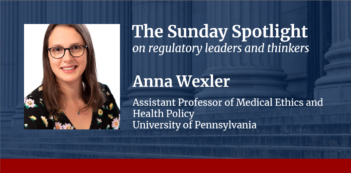
A new report offers recommendations for extending telehealth treatment of opioid use disorder.
When COVID-19 forced shutdowns last year, it collided with an opioid overdose crisis that has been decades in the making.
To limit face-to-face contact, the U.S. Drug Enforcement Administration (DEA) and the Substance Abuse and Mental Health Services Administration (SAMHSA) issued policies that made it easier for patients suffering with opioid use disorder (OUD) to gain access to critical medications in ways that would have been considered largely illegal pre-pandemic.
Once these temporary provisions expire, however, access to life-saving OUD treatments could erode—especially for those in rural areas.
In a new report from the George Washington University Regulatory Studies Center, Bridget C.E. Dooling and Laura Stanley urge the DEA and SAMHSA to consider three pathways to extend the telehealth flexibilities that were granted to practitioners during the COVID-19 public health emergency.
During the first year of the pandemic, the drug overdose death rate in the United States climbed to the highest level ever recorded in a 12-month period. Data released by the Centers for Disease Control and Prevention indicates more than 87,000 drug overdose deaths occurred between October 2019 and September 2020. The surge in death rates—driven primarily by synthetic opioids such as fentanyl—is now highest among African Americans.
Despite these statistics, federal and state regulations still impose substantial barriers to the delivery of evidence-based OUD treatments. Researchers argue that these regulatory hurdles pose further health risks by diverting users to illicit opioids. Separately, they may lead prescribers to provide insufficient management to their patients out of fear of regulatory sanctions.
In treating opiate addiction, the U.S. Food and Drug Administration (FDA) considers buprenorphine—a medication that eases the symptoms of withdrawal—to be one of the key treatment options.
Despite compelling evidence that addiction treatments, such as buprenorphine, can reduce the risk of death after opioid overdoses and help keep individuals in treatment programs, it remains underutilized. Federal regulations prevent clinicians from treating patients with buprenorphine until they complete special training and obtain a license—known as the “X” waiver—from the DEA. Up until the pandemic, practitioners without this waiver—which fewer than 10 percent of primary care providers possess—were prohibited from prescribing buprenorphine using telemedicine without first conducting an in-person medical evaluation.
In the context of the pandemic, buprenorphine prescribers have been able to transition to offering telemedicine visits, which has made it easier for patients suffering with OUD to begin treatment regardless of their location.
The DEA has stated that as the public health emergency eases, the telehealth provisions would need to return to their pre-pandemic state because Congress has not given the DEA authority to remove these restrictions permanently. But Dooling and Stanley argue that the DEA and SAMHSA could extend pandemic-related flexibilities, such as the prescription of buprenorphine without an initial, in-person medical evaluation, on their own.
Although the extensions could be enacted through legislative action, Dooling and Stanley offer potential pathways that the Biden Administration could take to expand treatment for OUD without waiting for Congress to act. According to Dooling and Stanley, the DEA and SAMHSA have the legal authority to leverage change in three ways.
The Ryan Haight Online Pharmacy Consumer Protection Act—although written to prevent the sale of controlled substances over the internet—enables the DEA and SAMHSA to issue new regulations that allow practitioners to prescribe OUD treatment such as buprenorphine without the need for an in-person medical evaluation. Dooling and Stanley explain that the language of the Ryan Haight Act “unambiguously gives the DEA and SAMHSA authority to extend the prescription of controlled substances using telemedicine.”
Dooling and Stanley note that the first option is “well grounded in the law.” As an alternative, the DEA could also establish a special registration program, which it is required to do by law but has not yet done, to regulate providers using telehealth. SAMHSA would also need to issue a companion policy that would apply to opioid treatment programs specifically.
Dooling and Stanley indicate that, although the current telehealth flexibilities were granted in response to a COVID-19 public health emergency that could expire or be revoked, SAMHSA and the DEA could extend treatment programs under a concurrent public health emergency that was declared in 2017 specific to the opioid crisis. Dooling and Stanley explain that, just as the DEA used its authority at the beginning of the pandemic, “it has the discretion as a matter of law to use that authority to extend that policy under the opioid-specific public health emergency.”
It is no doubt that healthcare delivery has been profoundly disrupted by COVID-19. As the current Administration grapples with how to address two twin health emergencies, Dooling and Stanley’s report highlights key regulatory mechanisms available to federal agencies that have the potential to improve access to critical OUD treatment even after the COVID crisis comes to an end.



